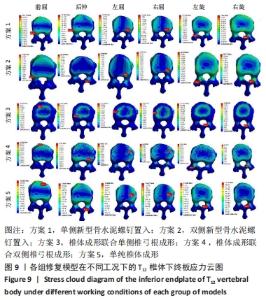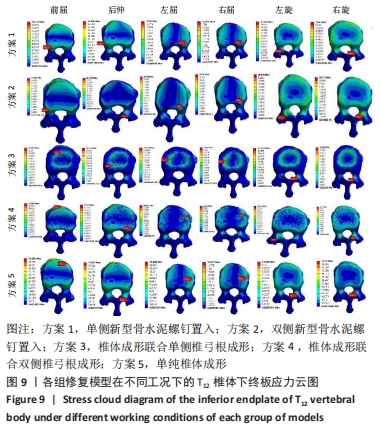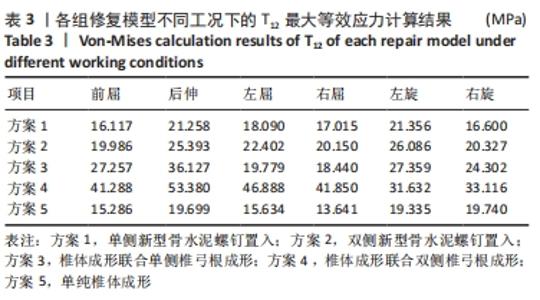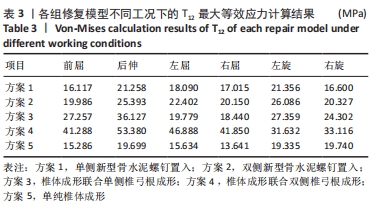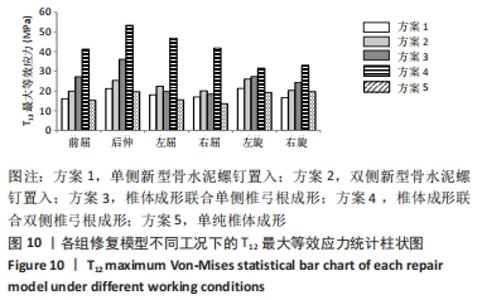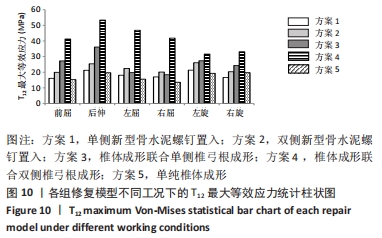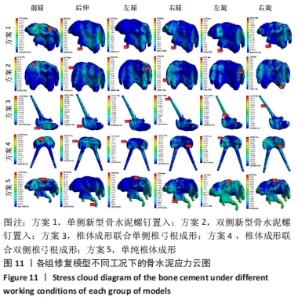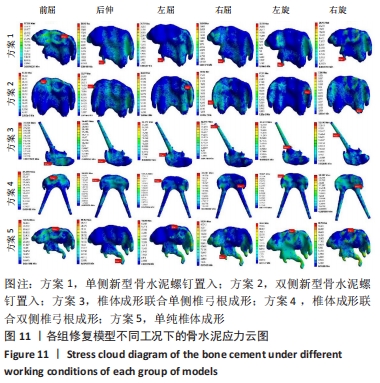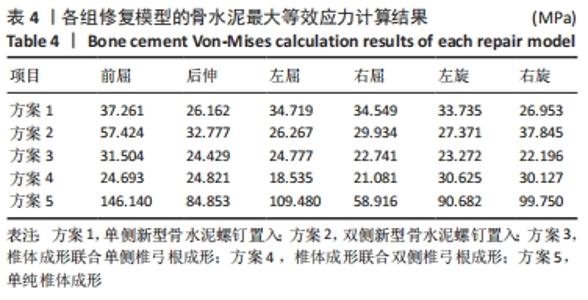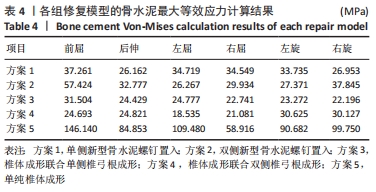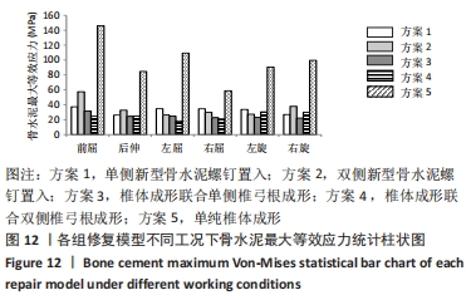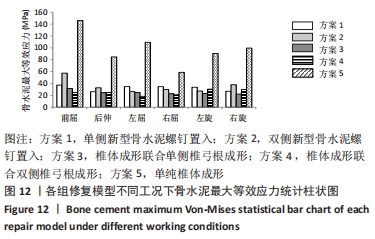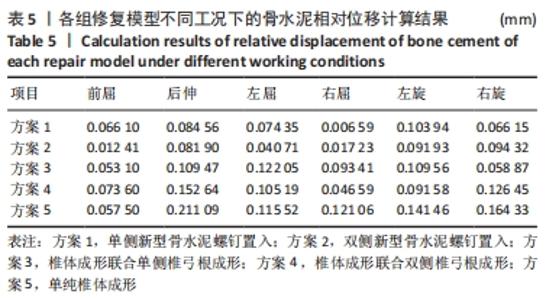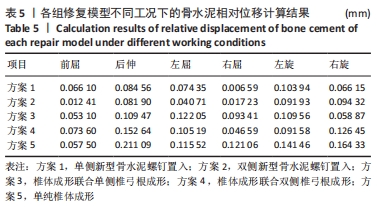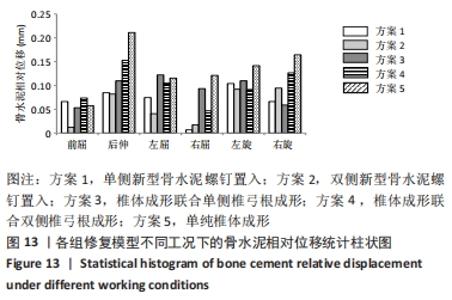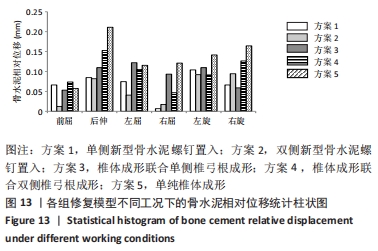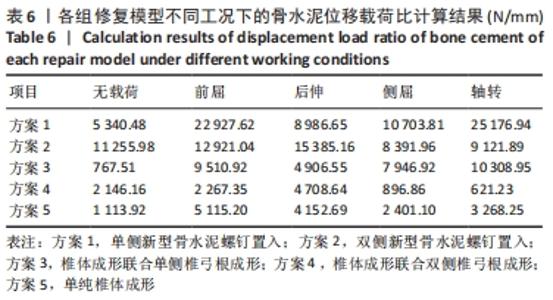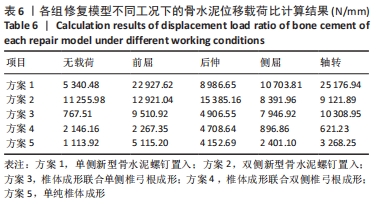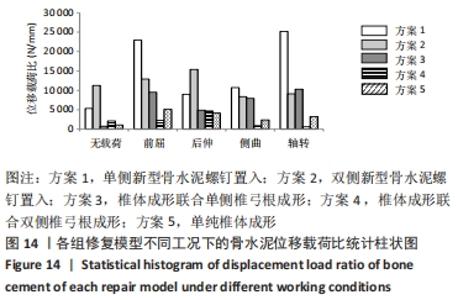Chinese Journal of Tissue Engineering Research ›› 2022, Vol. 26 ›› Issue (21): 3381-3388.doi: 10.12307/2022.648
Previous Articles Next Articles
Biomechanical properties of a novel bone cement screw and traditional methods for Kummell’s disease
Zhan Yi1, 2, Kang Xin1, Wang Yuhang1, Zhang Haiping1, He Simin1, Sun Honghui1, Hao Dingjun1, Wang Biao1
- 1Honghui Hospital, Xi’an Jiaotong University, Xi’an 710054, Shaanxi Province, China; 2Shaanxi University of Chinese Medicine, Xi’an 712046, Shaanxi Province, China
-
Received:2021-07-20Accepted:2021-09-16Online:2022-07-28Published:2022-01-27 -
Contact:Wang Biao, MD, Associate chief physician, Honghui Hospital, Xi’an Jiaotong University, Xi’an 710054, Shaanxi Province, China -
About author:Zhan Yi, Master candidate, Honghui Hospital, Xi’an Jiaotong University, Xi’an 710054, Shaanxi Province, China; Shaanxi University of Chinese Medicine, Xi’an 712046, Shaanxi Province, China -
Supported by:National Natural Science Foundation of China, No. 81802167 (to WB); Key Research and Development Program of Shaanxi Province, No. 2020GXLH-Y-003 (to WB); Key Research and Development Program of Shaanxi Province, No. 2020SFY-095 (to HSM)
CLC Number:
Cite this article
Zhan Yi, Kang Xin, Wang Yuhang, Zhang Haiping, He Simin, Sun Honghui, Hao Dingjun, Wang Biao. Biomechanical properties of a novel bone cement screw and traditional methods for Kummell’s disease[J]. Chinese Journal of Tissue Engineering Research, 2022, 26(21): 3381-3388.
share this article
Add to citation manager EndNote|Reference Manager|ProCite|BibTeX|RefWorks
| [1] CUI L, CHEN L, XIA W, et al. Vertebral fracture in postmenopausal Chinese women: a population-based study. Osteoporos Int. 2017; 28(9):2583-2590. [2] RAJASEKARAN S, KANNA RM, SCHNAKE KJ, et al.Osteoporotic Thoracolumbar Fractures-How Are They Different?-Classification and Treatment Algorithm. J Orthop Trauma. 2017;31 Suppl 4:S49-S56. [3] 王复案,陈允震.骨质疏松性椎体压缩性骨折诊疗现状及其对策[J].中国骨质疏松杂志,2019,25(5):590-594,599. [4] 吴斗,刘强.骨质疏松性骨折手术治疗策略[J].中国骨质疏松杂志, 2019,25(5):581-584. [5] OSTERHOUSE MD, KETTNER NW. Delayed posttraumatic vertebral collapse with intravertebral vacuum cleft. J Manipulative Physiol Ther. 2002;25(4):270-275. [6] YOUNG WF, BROWN D, KENDLER A, et al. Delayed post-traumatic osteonecrosis of a vertebral body (Kummell’s disease). Acta Orthop Belg. 2002;68(1):13-19. [7] LIBICHER M, APPELT A, BERGER I, et al. The intravertebral vacuum phenomen as specific sign of osteonecrosis in vertebral compression fractures: results from a radiological and histological study. Eur Radiol. 2007;17(9):2248-2252. [8] MATZAROGLOU C, GEORGIOU CS, ASSIMAKOPOULOS K, et al. Kümmell’s disease: pathophysiology, diagnosis, treatment andthe role of nuclear medicine. Rationale according to our experience. Hell J Nucl Med. 2011;14(3):291-299. [9] FENG SW, CHANG MC, WU HT, et al. Are intravertebral vacuum phenomena benign lesions? Eur Spine J. 2011;20(8):1341-1348. [10] 李良辰,何登伟,黄文君,等.Kummell病椎体裂隙征发生机制的研究进展[J].中华骨质疏松和骨矿盐疾病杂志,2015,8(4):363-366. [11] YU CW, HSU CY, SHIH TT, et al. Vertebral osteonecrosis: MR imaging findings and related changes on adjacent levels. AJNR Am J Neuroradiol. 2007;28(1):42-47. [12] 邵明昊,吕飞舟,马晓生,等. 腰椎皮质骨钉道螺钉在骨质疏松症患者中应用的三维有限元分析[J]. 中华老年骨科与康复电子杂志, 2015(2):1-6. [13] KUMARESAN S, YOGANANDAN N, PINTAR FA. Finite element analysis of the cervical spine: a material property sensitivity study. Clin Biomech (Bristol, Avon). 1999;14(1):41-53. [14] 蔡凯文,蒋国强,卢斌,等.椎间隙骨水泥渗漏的不同分型对邻椎相邻终板应力分布的影响:三维有限元研究[J].中华骨科杂志,2019, 39(6):364-373. [15] STEEL HH. Kümmell’s disease. Am J Surg. 1951;81(2):161-167. [16] CHEN L, DONG R, GU Y, et al. Comparison between Balloon Kyphoplasty and Short Segmental Fixation Combined with Vertebroplasty in the Treatment of Kümmell’s Disease. Pain Physician. 2015;18(4):373-381. [17] NIU J, SONG D, ZHOU H, et al. Percutaneous Kyphoplasty for the Treatment of Osteoporotic Vertebral Fractures With Intravertebral Fluid or Air: A Comparative Study. Clin Spine Surg. 2017;30(8):367-373. [18] WANG F, WANG D, TAN B, et al. Comparative Study of Modified Posterior Operation to Treat Kümmell’s Disease. Medicine (Baltimore). 2015;94(39):e1595. [19] ZHANG X, HU W, YU J, et al. An Effective Treatment Option for Kümmell Disease With Neurological Deficits: Modified Transpedicular Subtraction and Disc Osteotomy Combined With Long-Segment Fixation. Spine (Phila Pa 1976). 2016;41(15):E923-E930. [20] LIM J, CHOI SW, YOUM JY, et al. Posttraumatic Delayed Vertebral Collapse : Kummell’s Disease. J Korean Neurosurg Soc. 2018;61(1):1-9. [21] PEH WC, GELBART MS, GILULA LA, et al. Percutaneous vertebroplasty: treatment of painful vertebral compression fractures with intraosseous vacuum phenomena. AJR Am J Roentgenol. 2003; 180(5):1411-1417. [22] MA R, CHOW R, SHEN FH. Kummell’s disease: delayed post-traumatic osteonecrosis of the vertebral body. Eur Spine J. 2010;19(7):1065-1070. [23] LIU F, CHEN Z, LOU C, et al. Anterior reconstruction versus posterior osteotomy in treating Kümmell’s disease with neurological deficits: A systematic review. Acta Orthop Traumatol Turc. 2018;52(4):283-288. [24] KRAUSS M, HIRSCHFELDER H, TOMANDL B, et al. Kyphosis reduction and the rate of cement leaks after vertebroplasty of intravertebral clefts. Eur Radiol. 2006;16(5):1015-1021. [25] CHEN GD, LU Q, WANG GL, et al. Percutaneous Kyphoplasty for Kummell Disease with Severe Spinal Canal Stenosis. Pain Physician. 2015;18(6):E1021-1028. [26] 陈峰,方文来.Kummell病的治疗进展[J].中国骨与关节损伤杂志, 2013,28(1): 95-96. [27] ZHANG J, FAN Y, HE X, et al. Is percutaneous kyphoplasty the better choice for minimally invasive treatment of neurologically intact osteoporotic Kümmell’s disease? A comparison of two minimally invasive procedures. Int Orthop. 2018;42(6):1321-1326. [28] 王小刚,杨彬,王亚寒,等.单侧穿刺椎体成形术治疗Kummell病的疗效观察[J].中国矫形外科杂志,2019,27(1):86-88. [29] LI HK, HAO DJ, YANG JS, et al. Percutaneous kyphoplasty versus posterior spinal fixation with vertebroplasty for treatment of Kümmell disease: A case-control study with minimal 2-year follow-up. Medicine (Baltimore). 2017;96(51):e9287. [30] HUANG YS, HAO DJ, FENG H, et al. Comparison of Percutaneous Kyphoplasty and Bone Cement-Augmented Short-Segment Pedicle Screw Fixation for Management of Kümmell Disease. Med Sci Monit. 2018;24:1072-1079. [31] HUANG YS, GE CY, FENG H, et al. Bone Cement-Augmented Short-Segment Pedicle Screw Fixation for Kümmell Disease with Spinal Canal Stenosis. Med Sci Monit. 2018;24:928-935. [32] ZHANG GQ, GAO YZ, ZHENG J, et al. Posterior decompression and short segmental pedicle screw fixation combined with vertebroplasty for Kümmell’s disease with neurological deficits. Exp Ther Med. 2013; 5(2):517-522. [33] DI HX, LIU FY, YANG SD, et al. Short-segment fixation with a cement-augmented pedicle screw for Kummell disease: Case report. Medicine (Baltimore). 2017;96(50):e8617. [34] LEE K, ADSUL N, KIM HS, et al. Percutaneous Pedicle Screw Fixation with Bone Cement Augmentation Under Epidural Anesthesia for Treatment of Kümmell Disease in Extremely Old Age. World Neurosurg. 2018;119:506-510. [35] ZHANG C, WANG G, LIU X, et al. Failed percutaneous kyphoplasty in treatment of stage 3 Kummell disease: A case report and literature review. Medicine (Baltimore). 2017;96(47):e8895. [36] TSAI TT, CHEN WJ, LAI PL, et al. Polymethylmethacrylate cement dislodgment following percutaneous vertebroplasty: a case report. Spine (Phila Pa 1976). 2003;28(22):E457-460. [37] Nagad P, Rawall S, Kundnani V, et al. Postvertebroplasty instability. J Neurosurg Spine. 2012;16(4):387-393. [38] SEO DH, OH SH, YOON KW, et al. Risk Factors of New Adjacent Compression Fracture after Percutaneous Vertebroplasty: Effectiveness of Bisphosphonate in Osteoporotic or Osteopenic Elderly Patients. Korean J Neurotrauma. 2014;10(2):86-91. [39] 葛云林,陶利江,卢一生.经皮球囊扩张椎体后凸成形术术后再发椎体骨折的危险因素和防治策略[J]. 颈腰痛杂志,2016,37(5):404-407. [40] 陈新来,于志勇,黄春选,等.球囊扩张椎体后凸成形术后继发相邻节段椎体骨折的危险因素分析[J]. 中国骨与关节损伤杂志,2016, 31(1):51-53. [41] WANG D, LI Y, YIN H, et al. Three-dimensional finite element analysis of optimal distribution model of vertebroplasty. Ann Palliat Med. 2020; 9(3):1062-1072. [42] SU Y, REN D, JIANG M, et al. T1 finite element model of Kümmell’s disease shows changes in the vertebral stress distribution. Int J Clin Exp Med. 2015;8(11):20046-20055. [43] ERDEM I, TRUUMEES E, VAN DER MEULEN MC. Simulation of the behaviour of the L1 vertebra for different material properties and loading conditions. Comput Methods Biomech Biomed Engin. 2013; 16(7):736-746. |
| [1] | Wang Jianping, Zhang Xiaohui, Yu Jinwei, Wei Shaoliang, Zhang Xinmin, Xu Xingxin, Qu Haijun. Application of knee joint motion analysis in machanism based on three-dimensional image registration and coordinate transformation [J]. Chinese Journal of Tissue Engineering Research, 2022, 26(在线): 1-5. |
| [2] | Wei Guoqiang, Li Yunfeng, Wang Yi, Niu Xiaofen, Che Lifang, Wang Haiyan, Li Zhijun, Shi Guopeng, Bai Ling, Mo Kai, Zhang Chenchen, Xu Yangyang, Li Xiaohe. Biomechanical analysis of non-uniform material femur under different loads [J]. Chinese Journal of Tissue Engineering Research, 2022, 26(9): 1318-1322. |
| [3] | Yuan Jiabin, Zhu Zongdong, Tang Xiaoming, Wei Dan, Tan Bo, Xiao Chengwei, Zhao Ganlinwei, Liao Feng. Classification and reduction strategies for irreducible intertrochanteric femoral fracture based on anatomy [J]. Chinese Journal of Tissue Engineering Research, 2022, 26(9): 1341-1345. |
| [4] | Zhang Yufang, Lü Meng, Mei Zhao. Construction and verification of a full spine biomechanical model of adolescent scoliosis [J]. Chinese Journal of Tissue Engineering Research, 2022, 26(9): 1351-1356. |
| [5] | Zhang Jichao, Dong Yuefu, Mou Zhifang, Zhang Zhen, Li Bingyan, Xu Xiangjun, Li Jiayi, Ren Meng, Dong Wanpeng. Finite element analysis of biomechanical changes in the osteoarthritis knee joint in different gait flexion angles [J]. Chinese Journal of Tissue Engineering Research, 2022, 26(9): 1357-1361. |
| [6] | Bai Zixing, Cao Xuhan, Sun Chengyi, Yang Yanjun, Chen Si, Wen Jianmin, Lin Xinxiao, Sun Weidong. Construction and biomechanical analysis of ankle joint finite element model in gait cycle [J]. Chinese Journal of Tissue Engineering Research, 2022, 26(9): 1362-1366. |
| [7] | Liu Feng, Feng Yi. Finite element analysis of different Kirschner wire tension bands on transverse patella fractures during gait cycle [J]. Chinese Journal of Tissue Engineering Research, 2022, 26(9): 1367-1371. |
| [8] | Pan Baoshun, Fang Zhen, Gao Mingjie, Fang Guiming, Chen Jinshui. Design for posterior atlantoaxial internal fixation system with fusion cage based on imaging data [J]. Chinese Journal of Tissue Engineering Research, 2022, 26(9): 1372-1376. |
| [9] | Li Kun, Gao Erke, Xiong Feng, Wang Xing, Wu Danqi, Li Zhijun, Zhang Shaojie, Liu Yanan, Duo Lan, Li Ziyu. Feasibility of axial transpedicle screw internal fixation in children aged 1 to 6 years [J]. Chinese Journal of Tissue Engineering Research, 2022, 26(9): 1383-1387. |
| [10] | Wen Mingtao, Liang Xuezhen, Li Jiacheng, Xu Bo, Li Gang. Mechanical stability of Sanders II type calcaneal fractures fixed by two internal fixation methods [J]. Chinese Journal of Tissue Engineering Research, 2022, 26(6): 838-842. |
| [11] | Wang Hailong, Li Long, Maihemuti·Yakufu, Chen Hongtao, Liu Xu, Yilihamu·Tuoheti. Finite element analysis of stress distribution of acetabular prosthesis in the Lewinnek safety zone [J]. Chinese Journal of Tissue Engineering Research, 2022, 26(6): 843-847. |
| [12] | Huang Hao, Hong Song, Wa Qingde. Finite element analysis of the effect of femoral component rotation on patellofemoral joint contact pressure in total knee arthroplasty [J]. Chinese Journal of Tissue Engineering Research, 2022, 26(6): 848-852. |
| [13] | Zheng Yongze, Zheng Liqin, He Xingpeng, Chen Xinmin, Li Musheng, Li Pengfei, Lin Ziling. Extended finite element modeling analysis of femoral neck fracture based on ABAQUS software [J]. Chinese Journal of Tissue Engineering Research, 2022, 26(6): 853-857. |
| [14] | Wei Bing, Chang Shan. Finite element analysis of different angles of nail placement in sagittal plane of spinal fracture [J]. Chinese Journal of Tissue Engineering Research, 2022, 26(6): 864-869. |
| [15] | Liu Yuhang, Zhou Jianqiang, Xu Xuebin, Qu Xingyue, Li Ziyu, Li Kun, Wang Xing, Li Zhijun, Li Xiaohe, Zhang Shaojie. Establishment and validation of finite element model of lower cervical spine in 6-year-old children [J]. Chinese Journal of Tissue Engineering Research, 2022, 26(6): 870-874. |
| Viewed | ||||||
|
Full text |
|
|||||
|
Abstract |
|
|||||
